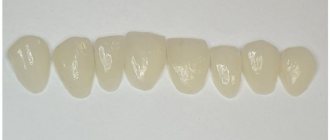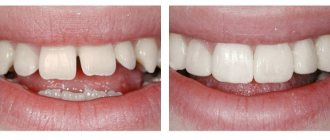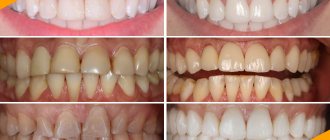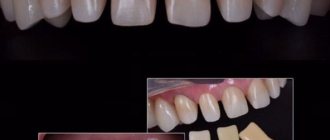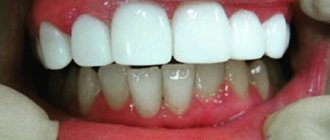A natural white-toothed smile is no longer a luxury, but a requirement that modern society makes of every person. Some people manage to keep their natural teeth for a long time thanks to high-quality care, while others are forced to seek help from a professional. It is then that, if indicated, ceramic or composite veneers - ultra-thin plates (onlays) that are attached to the teeth using special glue - help improve the aesthetics of teeth in the smile area.
As a rule, these microprostheses are used to “mask” minor aesthetic imperfections – chips, cracks, and help “hide” the large distance between individual units. Veneers are the best choice for those whose enamel, for one reason or another, has lost its natural whiteness (for example, due to fluorosis) and cannot be professionally whitened. Ceramic (composite) plates are designed to hide minor aesthetic defects of teeth in the smile area.
Service life of dental veneers
Often, patients with problematic front teeth have a choice between installing veneers and crowns. On the one hand, you want to preserve the vitality of the pulp and cut down as little tissue as possible. On the other hand, you don’t want to remove the onlays and install crowns after a year or two. Let's try to figure out what determines the service life of veneers, in which cases they should be installed and in which they should not be installed.
The duration of wearing the pads is very individual. It depends on:
- material for manufacturing a microprosthesis;
- bite ;
- compliance with all technical conditions and parameters in the laboratory;
- compliance with the rules of tooth treatment and fixation by a doctor;
- thorough oral care and compliance with scheduled visits to the doctor;
- presence of bad habits in the patient.
Of course, Emax veneers are considered the most durable and reliable today, their service life reaches 10-15 years . Zirconium veneers have a similar service life due to the dense frame. Overlays made from ordinary ceramic mass last at least 5 years . At the same time, the service life of composite veneers is the shortest. As a rule, the unit price directly corresponds to the service life of the future structure.
Installation steps
The preparatory stage is of great importance.
- The dentist removes a layer of enamel equal to the thickness of the veneer. It is 0.4-0.6 millimeters. This will allow you to install the pads evenly and achieve maximum fit.
- An impression is taken of the teeth. Veneers are made from it in a technical laboratory. The patient is temporarily placed with plastic plates.
- Fitting of finished ceramic veneers is carried out. If there is discomfort, they are sent for revision.
- Once the onlays are made, the dentist removes the plastic protection and attaches the porcelain veneers. To attach them, dental cement is applied to the surface of the tooth. It hardens under the rays of an ultraviolet lamp. After this, the pads cannot be removed. Therefore, accuracy of installation before fixation is important.
Service life of ceramic veneers
As you know, several types of onlays are made from ceramics: classic, on a zirconium dioxide frame, E-max ultraneers, American lumineers. They all differ in the chemical composition of the mass, its density and strength, the underlying frame, on which the service life of ceramic veneers depends.
For example, German lithium silicate ceramics E-max is baked under pressure during the manufacturing process. This rids its structure of pores and other defects that can lead to chipping. This structure allows you to create plates with minimal thickness and the most natural appearance, which look decent on the front teeth.
Considering the reviews, the service life of veneers on a zirconium dioxide frame is even higher, 10-15 years or more . The reason for this is a dense metal frame under a layer of ceramic mass, which effectively withstands any load. But due to its presence, the natural appearance is lost; there is no translucency that is present in E-max plates. Zirconium linings have a matte finish and are thick. Accordingly, they require cutting off a larger layer of enamel and are more suitable for lateral teeth.
Of course, E-max ceramics are expensive even at cost, and microprostheses based on them cannot be in the same price category as other types. But, if such cladding is not affordable, you can install classic ceramic linings. In any case, the service life of veneers on ceramic teeth will be longer than that of direct composite ones.
There is another type of ceramic onlay - American super-thin lumineers, which are distinguished by the fact that they do not require cutting down the enamel at all. At the same time , veneers on American-made teeth last, according to the manufacturer, up to 20 years, although the warranty on them is only 5 years . There are also significant disadvantages - very high cost (from 700 USD per unit) and a long manufacturing process, because Original Lumineers can only be manufactured in the USA.
Service life of composite veneers
The short service life of composite veneers is one of their main disadvantages. Usually, after a year, the cladding looks unsightly and requires correction or complete covering. On average, they are worn for no more than 3 years, and during this period they can cause a lot of trouble to their owner due to cracks and chips . And any problems that arise with the front teeth require an urgent visit to the dentist, because... are very noticeable.
The main reasons why composite veneers do not last long are:
- Porosity of the material , the ability to absorb pigments from food. This leads to rapid darkening of the cladding.
- Low strength and resistance to loads.
- Production by the direct method directly in the oral cavity, when the material is exposed to steam from breathing and moisture .
Considering reviews of how long veneers on composite teeth last, we can conclude that they act more as a temporary structure. Their installation is justified when there is an urgent need to eliminate a defect before an important event. When undergoing routine treatment, it is better to immediately choose ceramic veneers, which last two to three times longer.
Contraindications
Sign up for a free consultation:
- due to erosion and demineralization of the enamel, cracks and chips appeared;
- incorrect position of teeth;
- yellowing of the top layer;
- the filling has changed its color to a darker one;
- curvature;
- partial destruction or rapid abrasion of the enamel.
These miraculous dental plates have a number of prohibitions, if violated, the structure will quickly collapse or lead to any complications. They cannot be installed in the following cases:
- problems with your bite or jaws;
- periodontitis or advanced caries;
- more than half of the teeth with chewing function are missing;
- enamel is too thin;
- bruxism during sleep;
- pathological abrasion;
- extreme sports, including martial arts;
- bad habits: drugs, smoking or alcohol.
The technology for installing veneers is always the same, however, how quickly veneers are placed directly depends on each patient individually. Stages:
- Examination of the patient's oral cavity.
- Listening to wishes and making proposals.
- The patient chooses the material and the exact shade of future veneers.
- Taking into account the selected samples, the surface of the dental units is prepared.
- Making an impression of the jaw.
- Checking the quality of the impression - the patient must make sure that there is no discomfort.
- The patient's teeth are prepared and special temporary plastic onlays are installed on them.
- After the veneers are made, the doctor will remove the temporary plates from the teeth, clean and dry their surface.
- Veneers are fixed with durable dental cement.
- Once the samples are completely fixed, the prosthetist will remove any remaining adhesive and check the correct bite.
Note that lumineers are installed much faster. The doctor takes an impression of the teeth and presents the finished plates, after which they are glued to the same cement. The absence of preparation means that after removing the products, the teeth will remain intact, i.e. will not suffer from turning.
In general, the procedure for installing any type of veneers is quite complex and, as we can see, consists of several stages. In general, it takes approximately one to two weeks, depending on the number of teeth that need to be repaired and the material chosen to create the veneers.
Indications for veneering are as follows:
- Change in shade and shape of the tooth.
- Defects of enamel and dentin.
- Cracks and chips as a result of injury or age-related wear.
- Pigmentation, demineralization of an area or the entire surface.
- Diastemas and trema.
- Displacement, curvature of teeth.
- Defect of a stable filling or crown (discoloration). Provided that the filling occupies less than 50% of the surface.
- Amelogenesis (improper development of enamel).
- Uneven contour of the neck.
There are two cladding methods:
- Straight . The restoration takes place in the patient's mouth, and the composite mixture is applied in layers. The method does not require preliminary grinding; only a small layer of enamel is removed. The finished structure is polished and ground.
- Indirect. Using impressions, the technician creates custom ceramic onlays. Before the procedure, the tooth is prepared (ground). The dentures are fixed with strong glue.
Before installing composite veneers, the dentist assesses the condition of the oral cavity, sanitizes, and replaces old fillings with new ones. Using a special scale, the shade of the material is selected. Then a thin layer of enamel of the tooth being restored is removed (no more than 0.7 mm). The surface is treated with a special compound and dried to ensure better adhesion.
The situation is different with the installation of ceramic veneers. The whole process takes about a week, since a specialist needs to make the overlays. The restoration takes place in several stages:
- Taking an impression using impression paste.
- Formation of a plaster model of the jaw in a dental laboratory.
- Making porcelain plates.
- Facing.
We suggest you read why inflammation of the gums occurs under a denture and how to correct the situation
The patient's teeth are prepared by removing a sufficient layer of enamel. After grinding, temporary veneers are attached to sensitive teeth. To relieve pain, the doctor may prescribe painkillers. The finished plates are adjusted and glued with composite glue or cement, irradiated with a lamp to quickly harden, and then the contours are aligned.
When visiting a dentist, the doctor must first examine the client’s medical history, and only then make a decision about installing such plates. If there are the following contraindications, then installation is strictly prohibited.
- Caries with subsequent complications.
- Bruxism (teeth grinding).
- Major pathologies in the bite.
- Insufficient enamel or its thinness.
- The dental units did not erupt completely.
- Diseases, including periodontal disease, periodontitis and gingivitis (in these cases, preliminary treatment is necessary).
There are often cases when a doctor refuses to install veneers if there are large fillings on the teeth or they are highly fragile. Such negative aspects do not guarantee a long service life of the products, because even the most durable option can fall off after a couple of months.
What determines how long veneers last on teeth?
Of course, with proper and regular care, even the simplest veneers can extend their shelf life. For example, if after installing composite onlays you do not eat or drink anything coloring (coffee, tea, juices) for the first week, and avoid biting hard foods while wearing them, they will retain their original appearance for a year or more.
To further increase the shelf life of veneers, you should visit your dentist twice a year for professional cleaning and joint correction . The presence of a microgap between the veneer and the tooth tissue leads to food clogging and the development of caries, which reduces the period of wearing veneers.
In addition to professional hygiene, daily tooth brushing is extremely important for all types of veneers. Caring for composite veneers also involves the correct selection of hygiene products. The composite material is sensitive to toothpaste; if it contains too large abrasive particles, it can wear off. If you choose a more gentle toothpaste with small particles, you can extend the service life of veneers on your teeth, avoiding their premature wear.
To prevent problems such as chips and cracks, you should forget about the habit of biting off threads with your teeth, opening bottles, gnawing crackers and nuts . If nighttime grinding (bruxism) is present, a mouth guard can be made to protect the guards from damage.
Veneers: harm, complications and consequences
After fixing the veneers, you should refrain from any food for 2-3 hours. In the next month after the procedure, it is not recommended to load your teeth with food that is too hard or contains small bones. How long do teeth hurt after grinding and what to do about it? After preparation, teeth may hurt for the first 3-4 days, even with temporary veneers, due to increased sensitivity.
We suggest you read: Is it possible to rinse your mouth with soda for stomatitis?
Grinded teeth are extremely susceptible to hot, cold and hard foods, so to reduce pain you should avoid such dishes. If necessary, you can take painkillers. If this does not help, you will need to visit the dentist again, since perhaps the temporary veneers were not precisely matched to the teeth.
Hollywood smile thanks to veneers How to care for veneers? Veneers require careful and thorough care, although everything is not as complicated as it might seem at first glance. For any person who respects hygiene, caring for the pads will not be a problem. And following simple rules will maximize the service life of microprostheses.
Brushing your teeth with high-quality toothpastes twice a day is the first and most important condition for maintaining healthy teeth under veneers. It is unacceptable to use brushes with hard bristles or cleaning compounds with abrasive particles.
